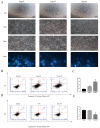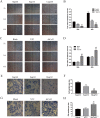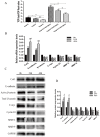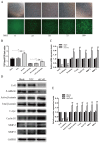Antitumor activity of resveratrol against human osteosarcoma cells: a key role of Cx43 and Wnt/β-catenin signaling pathway
- PMID: 29340064
- PMCID: PMC5762332
- DOI: 10.18632/oncotarget.22810
Antitumor activity of resveratrol against human osteosarcoma cells: a key role of Cx43 and Wnt/β-catenin signaling pathway
Abstract
Osteosarcoma is a high-grade bone sarcoma with strong invasive ability. However, treatment with traditional chemotherapeutic drugs is limited by low tolerability and side effects. Resveratrol has been reported previously to have selective antitumor effect on various tumor cells while little is known about its effects and underlying mechanism in osteosarcoma biology. In this study, we found that resveratrol inhibits proliferation and glycolysis, induces apoptosis and reduces the invasiveness of U2-OS cells in vitro. After treatment with resveratrol, the expression of related Wnt/β-catenin signaling pathway target genes, such as β-catenin, c-myc, cyclin D1, MMP-2 and MMP-9, was downregulated and an increased E-cadherin level was observed as well. Additionally, the dual luciferase assay results also indicated that resveratrol suppressed the activity of Wnt/β-catenin signaling pathway. Interestingly, we noticed that the expression of connexin 43 (Cx43) increased with the prolongation of resveratrol treatment time. To further investigate the relationship between Cx43 and the Wnt/β-catenin signaling pathway in osteosarcoma, we used lentiviral-mediated shRNA to knockdown the expression of Cx43. Knockdown of Cx43 activated the Wnt/β-catenin signaling pathway, promoted proliferation and invasion, and inhibited apoptosis of U2-OS cells. Taken together, our results demonstrate that the antitumor activity of resveratrol against U2-OS cells in vitro occurs through up-regulating Cx43 and E-cadherin, and suppressing the Wnt/β-catenin signaling pathway. Moreover, Cx43 expression is negatively related to the activity of the Wnt/β-catenin pathway in U2-OS cells.
Keywords: Wnt/β-catenin signaling; antitumor activity; connexin 43; osteosarcoma; resveratrol.
Conflict of interest statement
CONFLICTS OF INTEREST The authors declare that there are no conflicts of interest.
Figures





Similar articles
-
Inhibition of oleandrin on the proliferation show and invasion of osteosarcoma cells in vitro by suppressing Wnt/β-catenin signaling pathway.J Exp Clin Cancer Res. 2015 Oct 6;34:115. doi: 10.1186/s13046-015-0232-8. J Exp Clin Cancer Res. 2015. PMID: 26444270 Free PMC article.
-
Ganoderma lucidum Exerts an Anticancer Effect on Human Osteosarcoma Cells via Suppressing the Wnt/β-Catenin Signaling Pathway.Integr Cancer Ther. 2019 Jan-Dec;18:1534735419890917. doi: 10.1177/1534735419890917. Integr Cancer Ther. 2019. PMID: 31855073 Free PMC article.
-
Effects of SOST Gene Silencing on Proliferation, Apoptosis, Invasion, and Migration of Human Osteosarcoma Cells Through the Wnt/β-Catenin Signaling Pathway.Calcif Tissue Int. 2017 Jun;100(6):551-564. doi: 10.1007/s00223-016-0231-6. Epub 2017 Feb 28. Calcif Tissue Int. 2017. PMID: 28246931
-
Wnt/β-catenin signaling pathway: an attractive potential therapeutic target in osteosarcoma.Front Oncol. 2025 Feb 14;14:1456959. doi: 10.3389/fonc.2024.1456959. eCollection 2024. Front Oncol. 2025. PMID: 40028002 Free PMC article. Review.
-
Wnt signaling in osteosarcoma.Adv Exp Med Biol. 2014;804:33-45. doi: 10.1007/978-3-319-04843-7_2. Adv Exp Med Biol. 2014. PMID: 24924167 Review.
Cited by
-
miR-125 regulates PI3K/Akt/mTOR signaling pathway in rheumatoid arthritis rats via PARP2.Biosci Rep. 2019 Jan 8;39(1):BSR20180890. doi: 10.1042/BSR20180890. Print 2019 Jan 31. Biosci Rep. 2019. PMID: 30541899 Free PMC article.
-
Nature-derived compounds modulating Wnt/ β -catenin pathway: a preventive and therapeutic opportunity in neoplastic diseases.Acta Pharm Sin B. 2020 Oct;10(10):1814-1834. doi: 10.1016/j.apsb.2019.12.019. Epub 2020 Jan 7. Acta Pharm Sin B. 2020. PMID: 33163337 Free PMC article. Review.
-
TUFT1 Promotes Osteosarcoma Cell Proliferation and Predicts Poor Prognosis in Osteosarcoma Patients.Open Life Sci. 2018 Nov 9;13:396-403. doi: 10.1515/biol-2018-0048. eCollection 2018 Jan. Open Life Sci. 2018. PMID: 33817108 Free PMC article.
-
Reprogramming of glucose metabolism: Metabolic alterations in the progression of osteosarcoma.J Bone Oncol. 2024 Jan 4;44:100521. doi: 10.1016/j.jbo.2024.100521. eCollection 2024 Feb. J Bone Oncol. 2024. PMID: 38288377 Free PMC article. Review.
-
Connexin 43 Loss Triggers Cell Cycle Entry and Invasion in Non-Neoplastic Breast Epithelium: A Role for Noncanonical Wnt Signaling.Cancers (Basel). 2019 Mar 8;11(3):339. doi: 10.3390/cancers11030339. Cancers (Basel). 2019. PMID: 30857262 Free PMC article.
References
-
- Benjamin RS. Osteosarcoma: better treatment through better trial design. Lancet Oncol. 2015;16:12–13. - PubMed
-
- Lamoureux F, Trichet V, Chipoy C, Blanchard F, Gouin F, Redini F. Recent advances in the management of osteosarcoma and forthcoming therapeutic strategies. Expert Rev Anticancer Ther. 2007;7:169–181. - PubMed
-
- Moore DD, Luu HH. Osteosarcoma. Cancer Treat Res. 2014;162:65–92. - PubMed
-
- Gutowski CJ, Basu-Mallick A, Abraham JA. Management of bone sarcoma. Surg Clin North Am. 2016;96:1077–1106. - PubMed
LinkOut - more resources
Full Text Sources
Other Literature Sources
Research Materials
Miscellaneous

